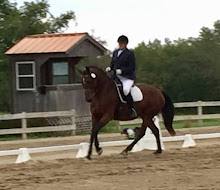Monday, December 9, 2013
2013 USDF Annual Convention - December 4th through December 8th.
The Annual Convention was located in Lexingto KY this year, right in the middle of horse country. December can be a little tricky and this early December was no exception. We left Wisconsin a day early to drive out of a storm and left Lexington Saturday evening instead of Sunday to avoid an ice storm. The convention was great - driving conditions were fair to poor.
The Board of Governers was really not overwhelmed with decision making. The only contested office that needed to be voted upon was Secretary of the Board for USDF. Margaret Freeman was elected to this position. She has a masters degree in journalism, an excellent choice. Lisa Gorretta, from region 2, ran unopposed for the position of Vice President.
The USDF is very proud of the National championship show that was held in Lexington this year. Next year the championships are scheduled to be at Gladstone.
There was a fair amount of talk about Intermediare being changed from 1 and 2 to A and B. This was done to make the steps towards grand Prix more gradual.
Some of the educational classes that I had time to attend were Degenerative Joint Diseas, Equine Rehabilitation and Preventative care, Schleese Saddle fit for life, colic and equine emergencies, and gastro intestinal health in the equine athlete. There were some ey opening facts in each session.
Degenerative Joint Disease and Equine Rehabilitation to me seemed fairly linked. It seems that giving Adequan every four days for 7 injections, was a helpful thing to do for your equine athlete. It really was one of those preventative options that can help your horse's joints long term. Adequan and Legend are the only FDA approved drugs that we have available for prevention and repair. Feeding joint supplements can help, but their absorbtion rate is quite a bit lower.
Shoeing and soundness were talked about as well. Someone asked about shoeing versus natural farrier trimming. The response was that it really depended on the ground you were working on. Some areas of the country were so rocky, that it would be hard to make the natural trimming work well even if it was done very well. The other statement was that the natural trimmer would have to trim the hoof once every 3 weeks and the owner could not rely on the natural wear pattern of the horse. That being said, may folks who show dressage ride their horses often enough and long enough that added support is frequently needed.
The training recommendation that was talked about was giving breaks during the training sessions. Allowing the joints to recover before moving on, is beneficial to your horse's joint health.
The Schleese saddle fitting classes were also interesting. Jochen Schleese talked about the different saddles needed for men and women. He showed a the difference in how the femur was tied into the pelvis and why the difference was needed. He stated that girls or women needed a narrower twist and a wider seat to be comfortable and secure in the saddle. The placement of the stirrup bars also needed to be adjusted. Jochen stated that lower back pain and pelvis pain are associated with women riding in saddles made for men.
Equine nutrition was also discussed and we talked about what kind of oil was best to use on feeds. Soybean Oil was the best option for oil that the horse would like the taste. Apparently, fish oil was even better but the horses are not liking the taste. The University of KY was playing with flavoring the fish oil with Cherry to make it easier for the horses to get used to. Oil decisions were made on which oils had more omega 3 verses omega 6 fats in them. The higher the ratio of Omega 3 the better.
When talking about horse feeds, the issue of insulin resistant horses came up. Those horses are fed a low carb diet to keep the sugar to a minimum to avoid founder issues. The other specialty group seemed to be the horses that tie up. Those horses also did better on high fat feeds. Also horses with ulcer symptoms seemed to do better on higher fats feeds as well. There is a lot of research going on right now about which feeds should be fed to which horses. Feeding your horses for peak performance is going to be an interesting field to watch.
The awards banquet on Saturday night was really nice. It is fun to see people doing well at all levels. This year I was there to pick up a bronze Freestyle Bar for the freestyles that I have ridden on Hazel and Bacara. The amount of equine knowledge in the room was very inspiring. One of the people that sat at our table was a trainer from California that trained at two farms, one for Hilda Gurney (trakehners), and then for a morgan breeding farm. I took the opportunity to talk with him about flying changes for horses with rounder more baroque bodies (like the Morgans). He shared with me some excersises that he likes for their body types. You never know where you will pick up more ideas!
If you would like to talk about any of these things in detail, let me know. I took many photos of the slides!
Thank you WWDA for sedning me to this conference as your GMO Rep!
Subscribe to:
Post Comments (Atom)

No comments:
Post a Comment
Note: Only a member of this blog may post a comment.